Ahmed a Thrive Agric Sorghum farmer in Dogon Dawa in Kaduna State planting his farmland.The effects of the current COVID19 pandemic ravaging the globe is threatening to upset the balance of Food security in Africa. Even though the number...
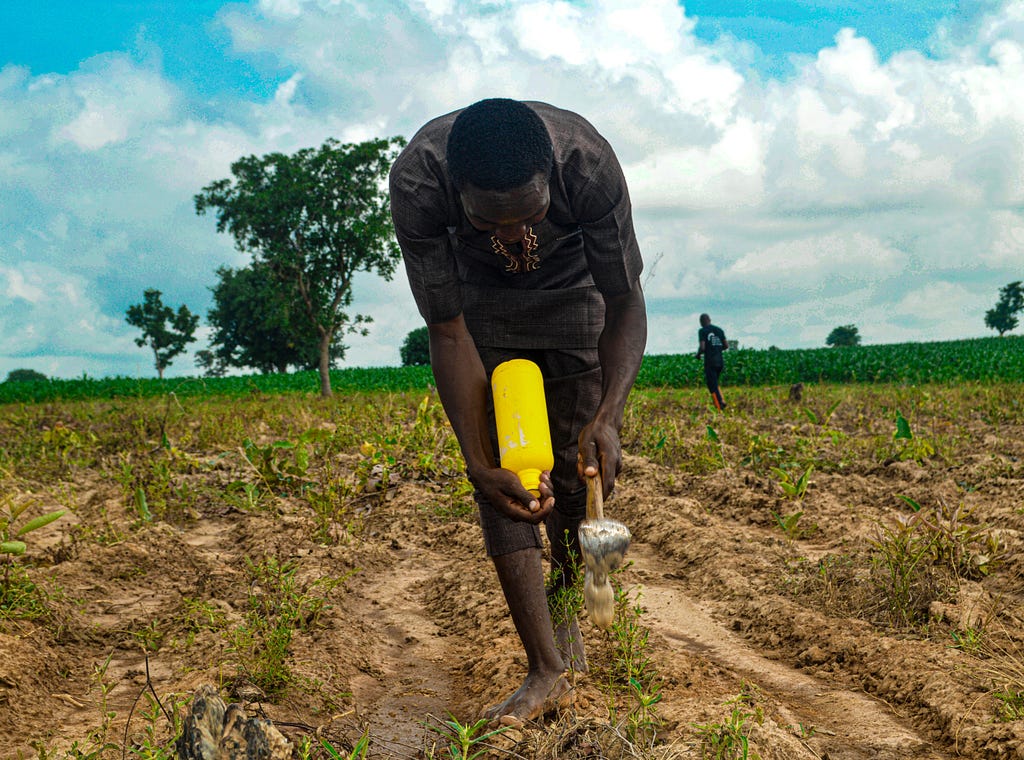 Ahmed a Thrive Agric Sorghum farmer in Dogon Dawa in Kaduna State planting his farmland.
Ahmed a Thrive Agric Sorghum farmer in Dogon Dawa in Kaduna State planting his farmland.The effects of the current COVID19 pandemic ravaging the globe is threatening to upset the balance of Food security in Africa. Even though the number of cases in Africa are growing at a slow rate, the secondary effects of the pandemic are depleting the continent’s food resources.
With the current sharp climb in food prices, labour shortages, and a huge drop in food supply to consumer markets, one has to ask, how will food security look like after the pandemic?
To fully understand and project what food security will look like in Africa after the pandemic, you have to first understand the challenges affecting food markets and the Agriculture chain at the moment.
The first question to ask and answer is, how food secure was Africa before the pandemic?
What did food security look like before the pandemic hit?
Food security in Africa is not only about the quantity of food produced and supplied to the consumer markets but also the quality of food available to people.
These numbers didn’t climb up overnight, but factors such as an unstable economy, sporadic change in Climate, and an ever increasing population contributed to it.
To make matters even dire, countless waves of locust swarms are ravaging some parts of East Africa, with Kenya, Tanzania, Uganda, Somalia, Ethiopia and some parts in South Sudan taking the worst hits.
This created not only an enormous hole in the food production and caused a vast set back to food security. This devastation could amount to $8.5 billion in losses at the end of 2020 if the governments and major industry players in the Agriculture industry across African countries don't put measures in place to mitigate the effect.
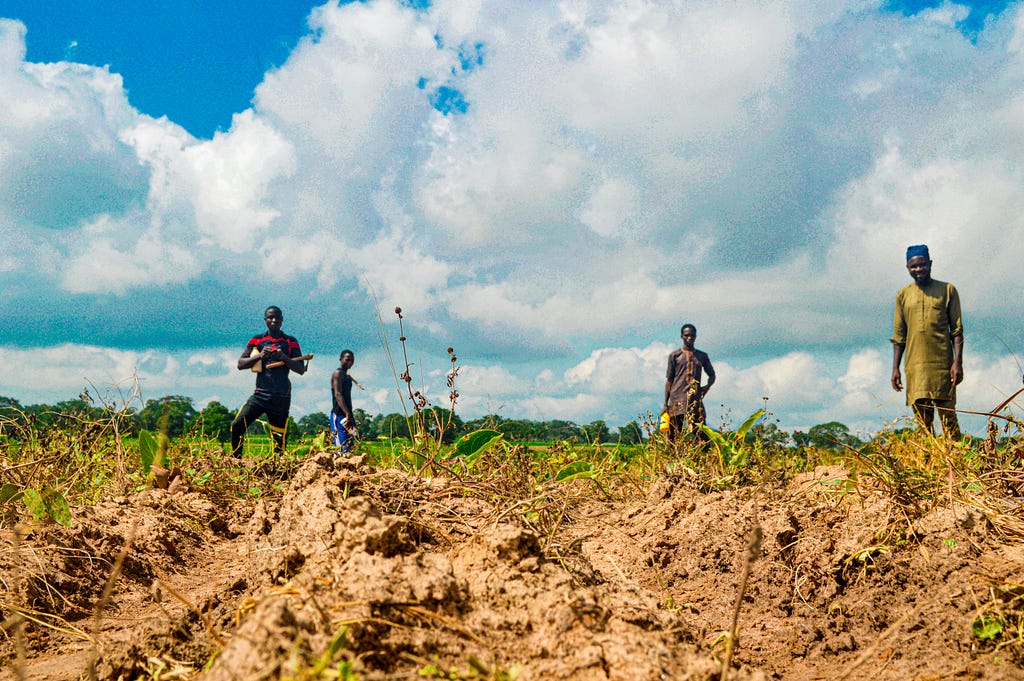 Ahmed and his Family on their Sorghum Farmland in Kaduna State.
Ahmed and his Family on their Sorghum Farmland in Kaduna State.In Nigeria where over 15% of the population are farmers, one would expect that food security would not be a problem but that is not the case. A hunger index built by the Lagos food bank initiative shows that over 91 million people in Nigeria have no food security. That is about 65% of the population which shows that a large percentage of the people in the country go to bed hungry every night.
The silver lining is that countries in Africa understand how bad things are and are taking steps to grow more food and reduce dependency on imports. Last year, the Nigerian government closed its borders to encourage food production in the country. At first, that made food prices skyrocket but gradually, prices stabilized until pandemic rocked the country's economy a few months ago.
Another sign that Nigerians recognize the urgency of food security is the rise in the number of digital platforms that fund Agriculture by providing farmers with quality inputs to increase yield.
Food security is not new to us at Thrive Agric. We built our foundations on the urgency to create an Africa that is food secure. It is the engine that drives and motivates all our decisions; to create an Africa that can feed the world and itself by empowering and capturing more value for smallholder farmers all across Nigeria and Africa.
In 2019, we worked with over 35000 farmers which saw us produce over 125000MT of grains and raise over 2 million birds across Nigeria. Earlier this year, we quickly moved to onboard 150000 farmers across Nigeria with the ThriveAOS technology. As always, the underlying thought on our minds was Food Security in Nigeria.
Moving forward to a few months ago when the pandemic hit the world, and the effects wrecked havoc across world economies, crashing markets around the country and bringing the entire world to an abrupt stop.
For a lot of businesses across different industries, it became an urgent matter of adapt or die. Many businesses adapted, transformed their business models, put structures in place to weather the storm and stay afloat.
At the moment, governments are easing up on the stringent restrictions that were in place to limit the spread of the virus and trying all they can to revive the economy.
What does the Agriculture industry look like now? How is the Food security at stake?
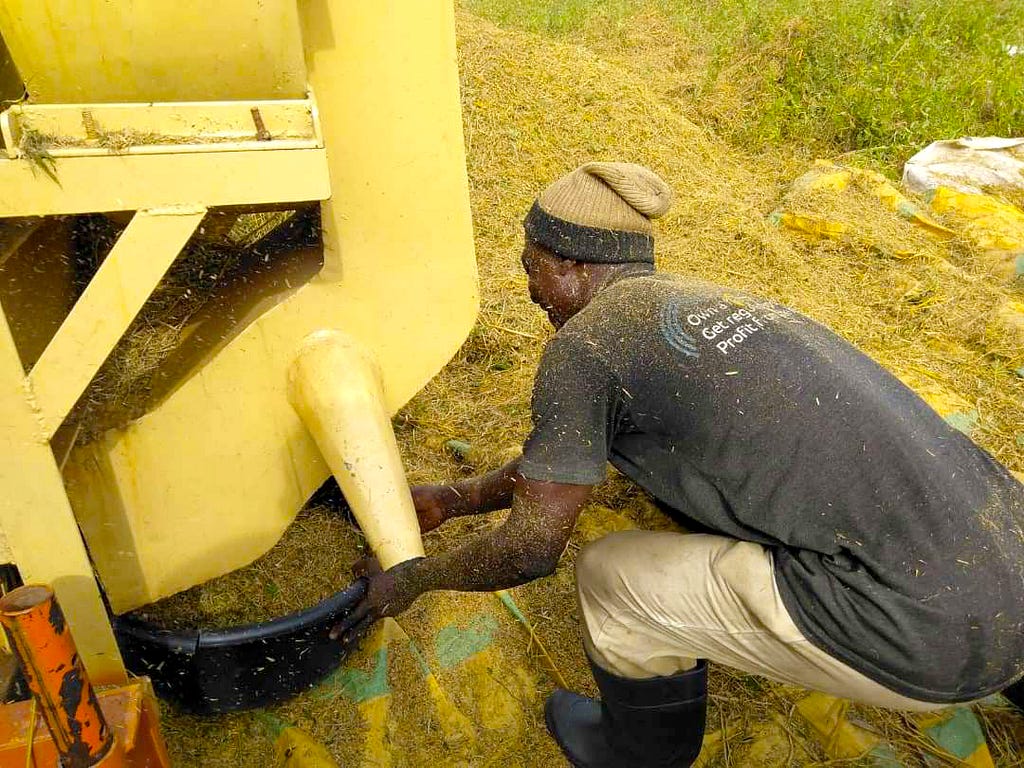 A Thrive Agric farmer using the rice Threshing machine after harvesting from his farm.
A Thrive Agric farmer using the rice Threshing machine after harvesting from his farm.The pandemic affected the different parts of the Agriculture value chain in different ways and varying magnitudes, some more than others. The production, distribution and delivery chain took the most hit because of the restriction in interstate movement and the high dependence on human labour. So, all processes from farms that produce raw materials to processing facilities significantly slowed down.
The shortage of labour also caused a block in the food supply chain, an increase in demand in the consumer markets and a hike in the price of commodities across markets in Nigeria. Also, processing facilities that rely on the supply coming from the farms now have a shortage of raw materials and therefore the supply of products to consumer markets and supermarkets also reduced. On the farms, the biggest challenge farmers face is that inputs can’t get to them because of the restrictions in movement and that creates a compounding effect on food production.
Unfortunately, a lot of farmers don’t produce enough from the previous farming cycle to cater for the next. So you can imagine their dilemma when the lockdown took effect and there were no clear channels to distribute inputs to them. To compound the problem, inputs like fertilizers and pesticides are scarce because Nigeria imports a large percentage from neighboring countries in Africa and outside Africa but ports are inaccessible as a result of the pandemic. Although the restrictions slowed down some of our operations, we've started input distribution in all our farming zones across Nigeria to prepare for our wet season project.
With things easing up in the country the big question is what will food security look like after the crisis? But to understand that, you first have to understand what food security looks like during this period.
What does food security look like now?
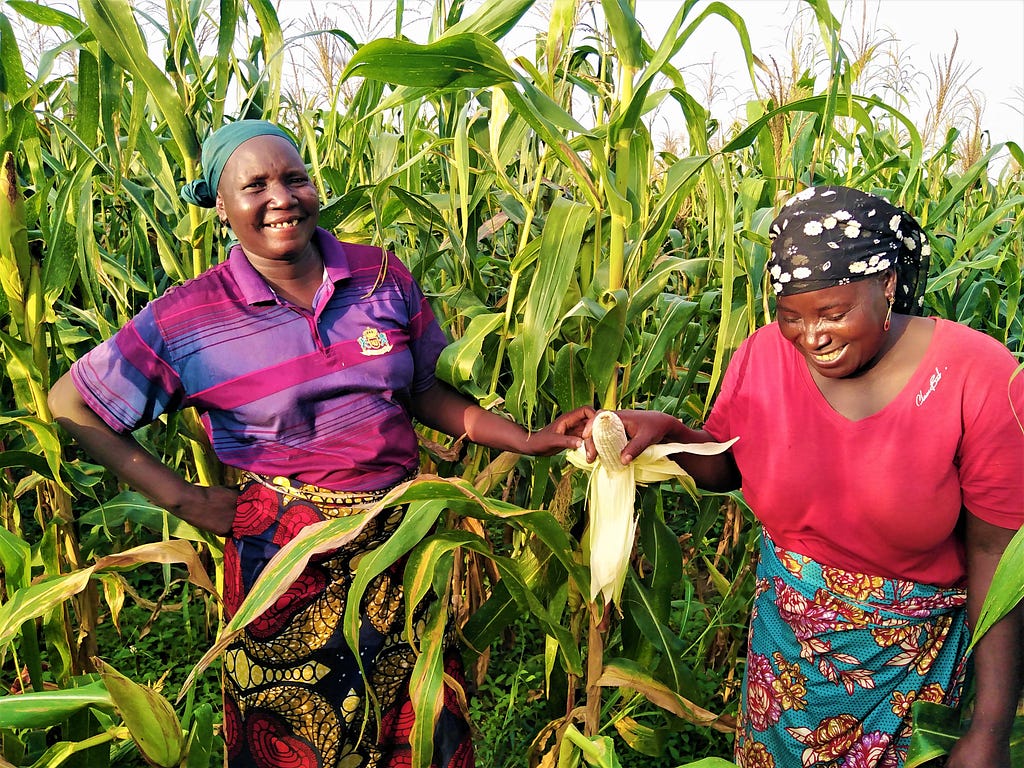 Elizabeth Yakubu a Thrive Agric maize farmer and her friend Abigail on their maize farm.
Elizabeth Yakubu a Thrive Agric maize farmer and her friend Abigail on their maize farm.The effect of the pandemic is evident in local food markets which rely on farms and processing facilities for processed and raw food supply. All you need to do is take a walk to any food market and ask for the price list of food commodities and it'll surprise you how food prices climbed these past few months.
Before the pandemic hit, a 100kg of maize grain sold for about NGN7000-NGN9500 across different commodity markets in Nigeria but now, prices are almost doubled with some markets selling as high as NGN15000. The same goes for a bag of paddy which sold for NGN10000 to NGN12000 but now a bag sells for as much as NGN16000. This price difference passes on to the wholesalers who increase the prices of commodities in the consumer market to put some profit in their pockets.
The big question is how do we ensure Food security and what can we collectively do during this period to avoid the looming food crisis?
A major part of these rests on the shoulder of the government and key industry players. The major challenge to ensure food security during this period is the restriction in movement, distribution channels and import channels. Distributors of inputs like fertilizers, seeds and pesticides should be recognized as essential workers and be given the freedom to move across interstate lines. Also, there should be clear channels to transport food from the farms to processing facilities and markets.
The government can also distribute inputs to farmers to encourage more production and increase food supply to the market.
What are we doing to increase food production and avoid food shortages in Nigeria?
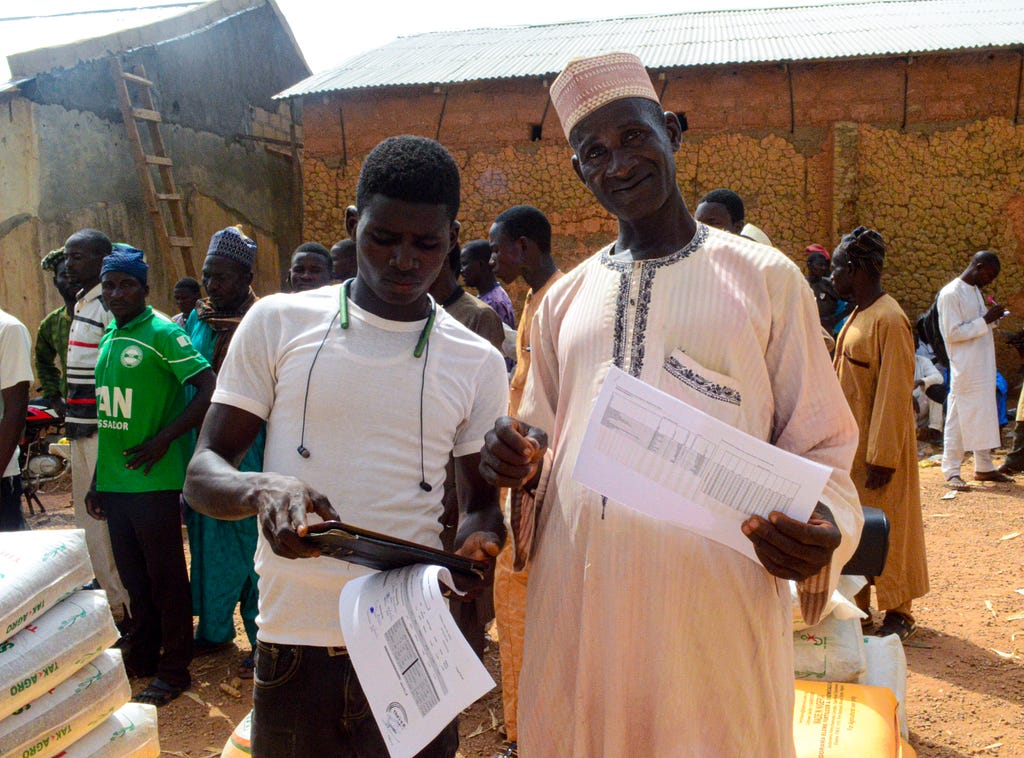 Yusuf a Thrive Agric officer, confirming a farmer’s information for input distribution in Soba, Kaduna.
Yusuf a Thrive Agric officer, confirming a farmer’s information for input distribution in Soba, Kaduna.During this period, Thrive Agric intends to solve the problem of access to input financing, tech-enabled extension services, and access to distribution and premium markets.
1. Technology for farmer onboarding and financing
We are currently leveraging our digital product; an Agriculture Operating System (AOS) to be used by our field Agents, the farmers and the banks to provide finance to the farmers, extension service and sales for their harvest, while digitizing how cash moves all through the cycle. This AOS has been able to digitally collate credit-worthy farmers on the field and match them with their field size and GPS locations.
2. Empower More Farmers with Access to Inputs and Premium Markets for Produce.
We are currently working with over 35,000 farmers in our network and have recently onboarded 150,000 more for crop operations. . We plan to invest in our agent network in 5 core Zones (Kaduna, Kebbi, and Kano, Jigawa, Bauchi) in Nigeria. Our target is to work with and drive agricultural productivity and profitability for over 250,000 over the next 12 months on our platform.
Our farmers who currently produce have seen an increase in their yield of up to 3X, and now have closer market linkages to processors who offer better prices and capture more value for them.
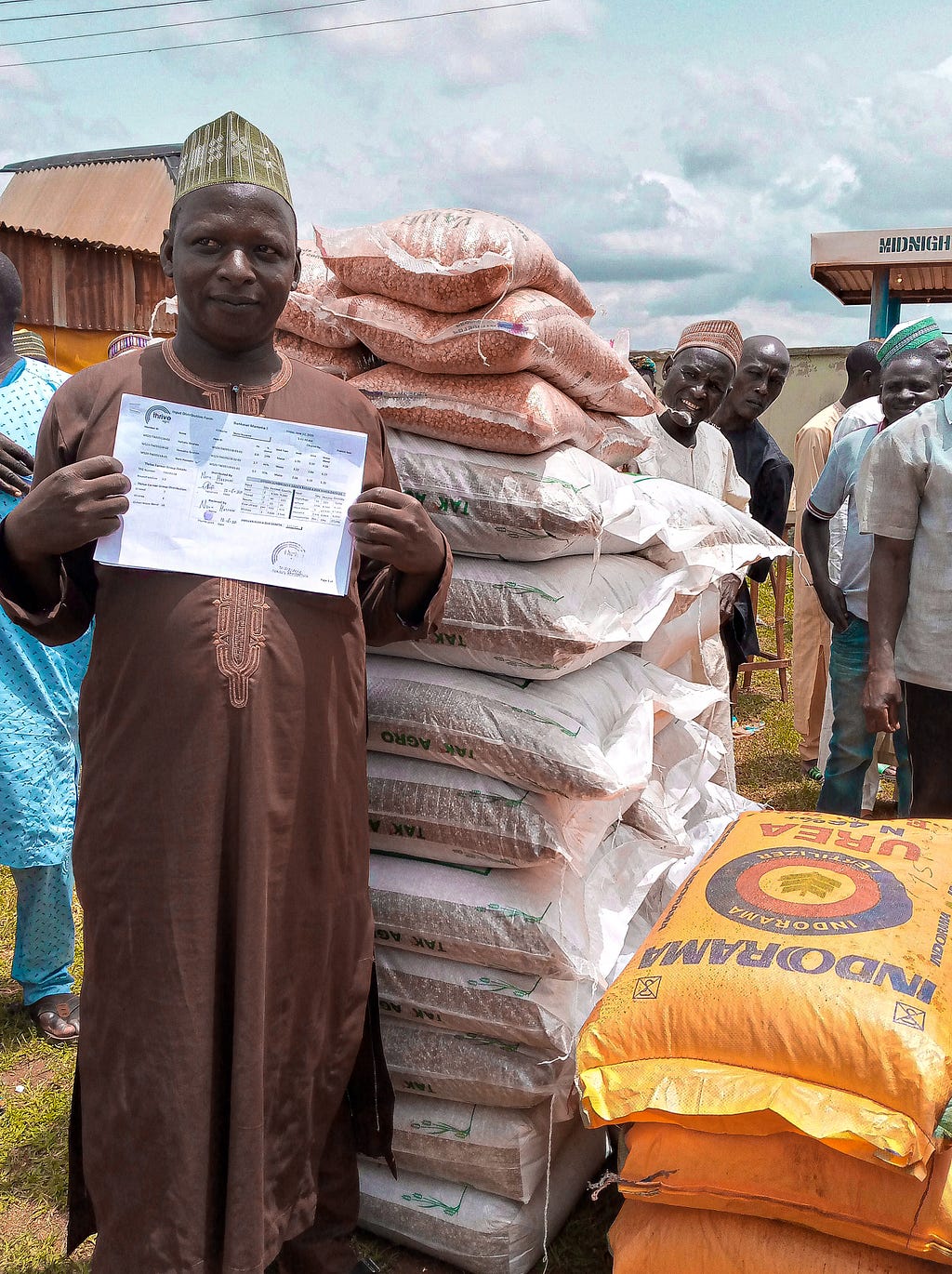 A Thrive Agric Farmer after collecting inputs in Saminaka, Kaduna State.
A Thrive Agric Farmer after collecting inputs in Saminaka, Kaduna State.3. Good Agronomy Practice
Our platform has enabled us to reach and educate farmers faster on good agronomy practice without physical structures. Various Agric-based educational contents are broadcasted to the farmers using various platforms and our extension service workers are available to demonstrate the practices.
Rice: Kebbi, Kaduna, and Kano states are the highest producers of rice in Nigeria but they currently produce 1.9 metric tons (MT). However, a Thrive Farmer produces over 4 MT per hectare.
Maize: Kaduna state is the largest producer of maize in Nigeria, but the farmers currently produce an average of 1.69 MT but the thrive farmers produce over 3.4MT.
Soybeans: Kebbi state is one of the largest producers of soybean in Nigeria but they produce 1 MT per hectare, but a Thrive Farmer produces up to 2 MT per hectare.
With 250,000 smallholder farmers whom we would be working with on an average of 0.7 hectare to a farmer, we would be producing an average of 2,000,000 MT of rice, maize, and soybean.
4. Access to Finance:
We currently are expanding the number of farmers with access to finance through partnerships with commercial banks and other institutional investors to provide input financing in addition to ours while riding on our existing technology platform and growing farmers network. With an increase in our financing pool, we can provide the farmers with quality inputs directly from the input providers alongside agronomy support and insurance for their farms.
5. Improved Distribution Channels
With an efficient aggregation frameworks that puts the farmers in clusters, we have been able to effectively link major input providers to the last mile (Farmers in this case) and also link the farmers to large offtakers which include Flour Mills of Nigeria, Stallion Rice e.t.c alongside the informal markets.
This full package of services will increase farmers’ yields and incomes and reduce the pre and post-harvest loss for the farmers which in turn will improve profitability across the entire value chain for Thrive Agric with attendant impact on the employment rate in host communities.
Although food security is in Africa at the moment, stability is not impossible. It would take more effort to give farmers access to all they need to increase food production, optimize processes that can reduce post-harvest losses, and create clear paths to distribute raw and processed food to consumer markets across the continent.
A prosperous Africa begins with you, let’s do more for our Farmers. Visit thriveagric.com to get started. Follow us on Twitter, Instagram, Facebook, LinkedIn and subscribe to our YouTube Channel to see our work improving the lives of local farmers in Nigeria and how we are building to ensure food security in Africa, one farmer at a time.
What will food security look like in Africa after the pandemic? was originally published in Hectare on Medium, where people are continuing the conversation by highlighting and responding to this story.








